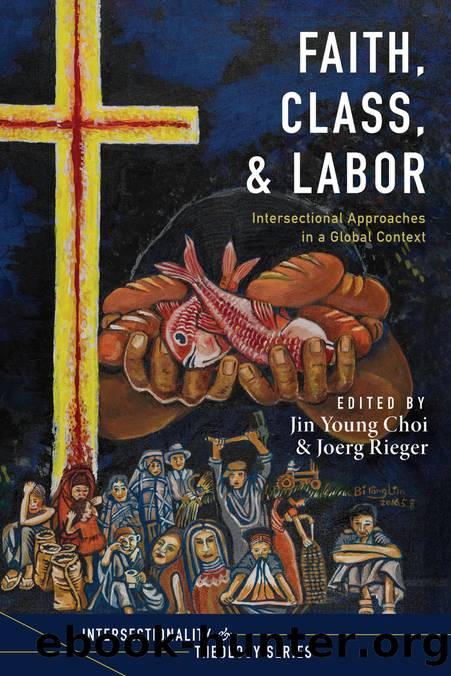Faith, Class, and Labor by Unknown

Author:Unknown
Language: eng
Format: epub
ISBN: 0000000000000
Published: 2021-05-27T15:42:27+00:00
Being the Other Woman
As mentioned earlier, Moab is constantly associated with deprivation, economic and otherwise. Musa Dube points out that the contrasting images of Israel to Moab shows how the latter is synonymous with barrenness, famine, and even death.
²â¸â¸
It also seems that marrying the people of the land whom in Ruth are foreign women, results in the death of all men in the family. This is not to mention that they are left with no sons.
²â¸â¹
Furthermore, it is possible to think of Boazâs subtle coercion of Mr. So-and-So to give up his right to Naomiâs estate toward the end of the story as demonstrating similar tropes about Moab. While it is debated how this would impoverish his estate, it is difficult to miss that the invoking of Ruthâs Moabite status is yet another association of Moab with potential loss and barrenness (Ruth 4:5â6). In light of this, it is hard to ignore that Ruthâs Moabite status is consistently emphasized throughout the narrative (Ruth 1:4, 22; 2:2, 6, 21; 4:5, 10).
In a similar fashion, Esperanzaâs status as a Filipina is evoked in the play mainly to reinforce her inferiority. She is ignorant and incompetent, a poor cook
²â¹â°
and is apparently incapable of performing âsimpleâ housework properly.
²â¹Â¹
Furthermore, her hygiene is often called into question culminating in her mistress spraying insecticide on her hair in a bid to rid her of âhead lice.â
²â¹Â²
Furthermore, such unsavory ideas about the other become salient during banal, everyday activities. When Cindy plays overnight mahjong with her friends, we find them picking on their hypersensuality and incompetence which is often interpreted as laziness. This is to say that one cannot underestimate how such activities contribute to what we presume to know about the Other.
Reading Ruth through Esperanzaâs struggle to please her employers makes me wonder how she would view Ruth. Phyllis Trible applauds Ruthâs determination when she remarks âhow difficult and courageous for a foreign woman to glean in the fieldâ while at the same time âhow healing and fulfilling for the empty Naomi to embrace Ruth the Moabite in the language of kinship [Ruth 2:20].â
²â¹Â³
So we have a Moabite woman who is willing to work jobs that mark the workers as poor and disenfranchised. Furthermore, she not only does what she is told, but also takes initiative to ensure her mother-in-law or as Esperanza would call Cindy, âmaâamâ is well taken care of. However, it would seem to me that in the eyes of Esperanza, Ruth is closer to Bonnie Honigâs model emigrée or Gale Yeeâs model minority and perpetual foreigner.
²â¹â´
What makes Ruth exceptional is that the needs of Naomi (as a woman of the host culture) will always supersede her own (as a foreign woman).
This brings me to my next point. In Esperanza, Cindy and her friends who are middle class members of the host culture often see themselves as benevolent to the lower class such as foreign domestic workers. For instance, Cindy compares herself to employers of old who
Download
This site does not store any files on its server. We only index and link to content provided by other sites. Please contact the content providers to delete copyright contents if any and email us, we'll remove relevant links or contents immediately.
The Lost Art of Listening by Michael P. Nichols(7169)
Why I Am Not A Calvinist by Dr. Peter S. Ruckman(4048)
The Rosicrucians by Christopher McIntosh(3373)
Wicca: a guide for the solitary practitioner by Scott Cunningham(3045)
Signature in the Cell: DNA and the Evidence for Intelligent Design by Stephen C. Meyer(2879)
Real Sex by Lauren F. Winner(2869)
The Holy Spirit by Billy Graham(2779)
To Light a Sacred Flame by Silver RavenWolf(2680)
The End of Faith by Sam Harris(2637)
The Gnostic Gospels by Pagels Elaine(2400)
Waking Up by Sam Harris(2332)
Nine Parts of Desire by Geraldine Brooks(2283)
Jesus by Paul Johnson(2230)
Devil, The by Almond Philip C(2207)
The God delusion by Richard Dawkins(2192)
Heavens on Earth by Michael Shermer(2190)
Kundalini by Gopi Krishna(2094)
Chosen by God by R. C. Sproul(2057)
The Nature of Consciousness by Rupert Spira(1983)
